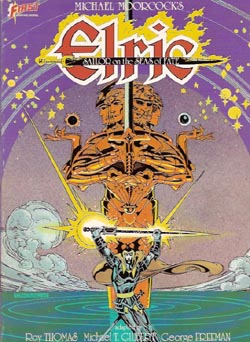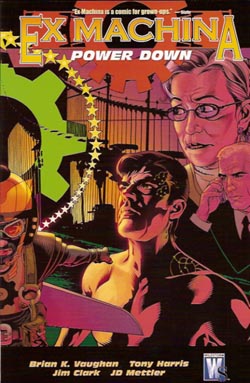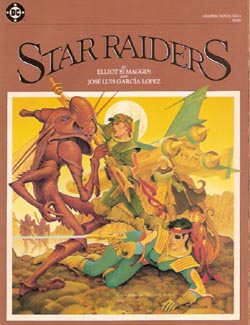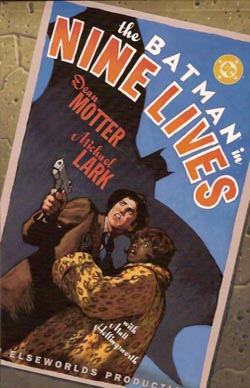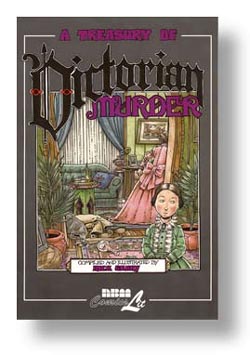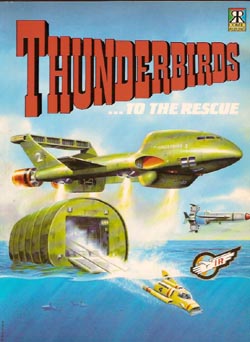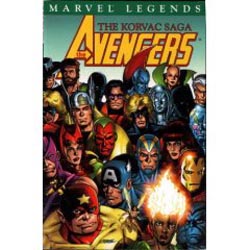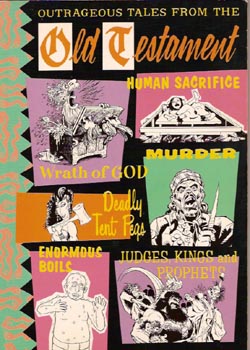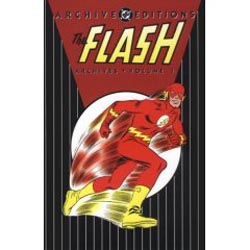
By Bob Kanigher, John Broome, Carmine Infantino & various (DC Comics)
ISBN: 1-56389-139-5
No matter which way you look at it, the Silver Age of the American comic book began with The Flash. It’s an unjust but true fact that being first is not enough; it also helps to be best and people have to notice. The Shield beat Captain America to the news-stands by over a year but the former is all but forgotten today.
The industry had never really stopped trying to revive the superhero genre when Showcase #4 was released in late summer of 1956, with such recent precursors as The Avenger (February-September 1955), Captain Flash (November 1954-July 1955), Marvel’s Human Torch, Sub-Mariner and the aforementioned Sentinel of Liberty (December 1953 – October 1955) and even DC’s own Captain Comet (December 1953 – October 1955) and Manhunter from Mars (November 1955 until the end of the 1960’s and almost the end of superheroes again!) still turning up in second-hand-stores and “Five-and-Dime†half-price bins. What made the new Fastest Man Alive stand out and stick was … well, everything!
Once the DC powers-that-be decided to try superheroes once more, they moved pretty fast themselves. Editor Julie Schwartz asked office partner and Golden-Age Flash scripter Robert Kanigher to recreate a speedster for the Space Age, aided and abetted by Carmine Infantino and Joe Kubert, who had also worked on the previous incarnation. The new Flash was Barry Allen, a forensic scientist simultaneously struck by lightning and bathed in the exploding chemicals of his lab. Supercharged by the accident, Barry took his superhero identity from a comic book featuring his predecessor (a scientist named Jay Garrick who was exposed to the mutagenic fumes of “Hard Waterâ€). Designing a sleek, streamlined bodysuit (courtesy of Infantino – a major talent who was just coming to his creative peak) Barry became the point man for the spectacular revival of a genre and an entire industry.
This lovely collection features not only all four Showcase tryout issues and the first four issues of his own title, but also kicks off with the very last Golden Age adventure from Flash Comics #104 (February 1949). In ‘The Rival Flash’ Kanigher, Infantino and inker Frank Giacoia re-examine that character’s origin when an evil scientist recreates the secret of his speed. Exuberant and avuncular, and very entertaining in its own right, it’s nonetheless a dated, clunky tale in comparison to its descendents.
In sharp counter-point ‘Mystery of the Human Thunderbolt’ (scripted by Kanigher) and ‘The Man Who Broke the Time Barrier’ (written by the superb John Broome) are polished, coolly sophisticated short stories that introduce the charmingly suburban new superhero and firmly establish the broad parameters of his universe. Whether defeating bizarre criminal masterminds such as The Turtle or returning the criminal exile Mazdan to his own century the new Flash was a protagonist of keen insight and sharp wits as well as overwhelming power.
Showcase #8 (June 1957) led with another Kanigher tale. ‘The Secret of the Empty Box’, a perplexing but pedestrian mystery, saw Frank Giacoia return as inker, but the real landmark is the Broome thriller ‘The Coldest Man on Earth’. With this yarn the author clinched the new phenomenon by introducing the first of a Rogues Gallery of outlandish super-villains. Unlike the Golden Age the new super-heroes would face predominantly costumed foes rather than thugs and spies. Bad guys would henceforth be as memorable as the champions of justice. Captain Cold would return time and again. Moreover, every single member of Flash’s pantheon of super-foes would be created by John Broome.
Joe Giella inked the two adventures in Showcase #13 (April 1958) ‘Around the World in 80 Minutes’, written by Kanigher and Broome’s ‘Master of the Elements’ which introduced the outlandish Mr Element, who returned in Showcase#14 (June 1958) with a new M.O. and identity — Doctor Alchemy. ‘The Man who Changed the Earth!’ is a great crime-caper, but Kanigher’s eerie ‘Giants of the Time-World!’ is a masterful fantasy thriller and a worthy effort to bow out on. When the Scarlet Speedster graduated to his own title John Broome was the main writer, supplemented eventually by Gardner Fox. Kanigher would return briefly in the mid-1960s and would later write a number of tales during DC’s ‘Relevancy’ period.
The Flash #105 launched with a February-March 1959 cover-date (so it was out for Christmas 1958) and featured Broome, Infantino and Giella’s Sci-Fi chiller ‘Conqueror From 8 Million B.C.!’ and introduced yet another super-villain in ‘The Master of Mirrors!’. The next issue introduced one of the most charismatic and memorable baddies in comics history. Gorilla Grodd and his hidden race of super-simians debuted in ‘Menace of the Super-Gorilla!’, promptly returning for the next two issues in ‘Return of the Super-Gorilla!’ (#107) and ‘The Super-Gorilla’s Secret Identity!’ (#108). Arguably this early confidence was fuelled by DC’s inexplicable pro-Gorilla editorial stance (for some reason any comic with a big monkey in it markedly outsold those that didn’t in those far-ago days) but these tales are also packed with tension, action and engagingly challenging fantasy concepts.
‘The Pied Piper of Peril!’ in #106 introduced another criminal menace, whilst the lead story in #107 ‘The Amazing Race Against Time!’ has our hero save the entire universe for the first time. With other superheroes breaking out, the Flash upped the stakes and stayed streets ahead of his competition. Issue #108’s non-gorilla story was another Sci-Fi thriller as extra-dimensional aliens try to kill our hero with ‘The Speed of Doom’ (inked by Frank Giacoia).
These early tales are historically vital to the development of our industry, but, quite frankly, so what? The first exploits The Flash should be judged solely on their merit, and on those terms they are punchy, awe-inspiring, beautifully illustrated and captivating thrillers that amuse, amaze and enthral both new readers and old devotees. This lovely volume is a must-read item for anybody in love with our art-form.
© 1949, 1956-1959, 1996, 2007 DC Comics. All Rights Reserved.
